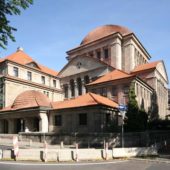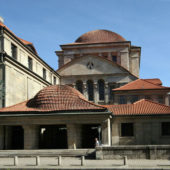Frankfurt’s largest synagogue post World War II
In November of 2010 the Westend Synagogue in Frankfurt, Germany celebrated its 100- year anniversary. It is one of the few synagogues in Germany to survive World War II. The Westend Synagogue is not only a place of worship, but also of commemoration and remembrance.
Jews in Frankfurt can be traced back to the 11th century. Frankfurt was a market town at that time. When Jews from Worms arrived in the 12th century, they rapidly prospered. However, this prosperity was only short-lived. In 1241, because the Jews would not convert to Christianity, over three-quarters of the 200 Jews were murdered and the remainder fled. By 1270 Emperor Frederick II, missing the loss of the tax revenue from the industrious Jews, protected them by enacting a strict penalty against anyone who would attack them. Therefore, the Jewish community again flourished, although they were required to pay heavy taxes.
In 1464, the Jewish community (comprised of 2200 members) was forced to live in a ghetto outside the city, as were most their brethren all over Europe. By 1610 the community numbered 3,000 members. Because the ghetto was never expanded, the homes were subdivided and upper stories were built to accommodate the increase in population. The community soon became a center of Ashkenazi Jewry and the yeshivas in the city attracted students from all over Europe. This enabled the community to grow wealthy. However, in 1624, the ghetto was raided and plundered by Vincent Fettmilch and his mob of disgruntled artisans and petty merchants. They were jealous of the Jews and owed them money, hence the attack. The emperor put Fettmilch to death and the rest of the mob in prison.
In 1711 the ghetto accidentally burnt to the ground; however, the homes and businesses were quickly rebuilt. Jewish unity started unraveling over disagreement about the Enlightenment and the conflict between Rabbi Jacob Emden and Rabbi Jonathen Eybeschuetz, which spread throughout Europe. Most prominent families lost their influence in Frankfurt, with the exception of the Rothschilds. Not until 1864 did Frankfurt’s Jewish community receive equal rights and fair treatment. After this time, Jews in Frankfurt enjoyed prosperity and they founded many charitable organizations. Many of the founders of Frankfurt’s Goethe University were Jewish and this was the first German university to appoint Jewish professors. Several Orthodox yeshivas were established, and one Reform yeshiva. Prior to 1933, the Jewish community in Frankfurt reached 28,000 members, including names such as: Ludwig Böme, Max Beckmann, the Rothschilds, the Oppenheimers, Paul Ehrlich, and Theodor Adorno.. Many Jews fought for Germany in WWI. Today, there are approximately 7,000 Jews in Frankfurt.
The Westend Synagogue is the only synagogue in Germany to be free from the effects of
WW II and it is still in use today. It was constructed between 1908 and 1910, in the Moorish style. It’s massive exterior features gray brickwork with unusual roofing featuring two cupolas, and a series of rectangular and arched windows. Inside, the stunning gold prayer room features not only sweeping archways indicative of Moorish design, but also some Art Deco aspects in the decoration of green, brown and gold running along the sides and back of the sanctuary and decorating the Corinthian capitals of the columns running along the sides and back of the sanctuary. The cupola, in the center of the ceiling, is fantastically decorated with Art Deco styling, in green, gold and brown. A large chandelier drops down from the center of it to light the sanctuary. The wall on the bimah, at the front of the sanctuary, is highlighted by a massive arch and is decorated in different Art Deco geometric patterns and features lions, all in gold. The Aron Kodesh is constructed of an upright rectangular shiny gold casing, with a white Torah curtain featuring gold embroidery drawn across it. A slim metal gate is situated across the front of the platform. The tivah (reader’s desk) is located in the middle of the prayer-room. It is comprised of a simple platform, bench and podium. The women’s gallery is upstairs, situated under massive arches along the sides and back of the prayer-room and Art Deco paneling with similar decoration on the walls upstairs and on the cornicing downstairs beautifully compliment the gold room. Folding theater-style chairs fill the sanctuary.
The Westend Synagogue was renovated in 1950 and completely restored between 1989 and 1994.


